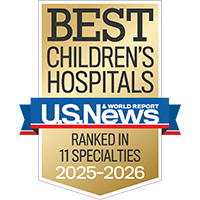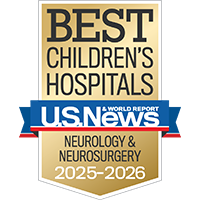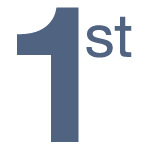Feeling at home
From bedside bingo to therapy dogs, we're here to help kids smile and feel more like themselves.
Visit Child Life services

Migraines are a type of headache. While often thought of as a condition that only adults get, migraine headaches are common in children, affecting 3% of preschool-age children, 4 to 11% of elementary school-age children, and 8 to 23% of high schoolers.
Before puberty, migraines are more common in boys; after puberty, they're more common in girls. Migraines often become more troublesome at the onset of puberty or even slightly before the outward signs of puberty appear. In girls, menstrual periods can be a potent migraine trigger, particularly for the first several years of cycling.
Migraines are most often hereditary. If a child has migraines, it's likely that a family member suffers from them, too. However, the severity and frequency of migraine attacks can differ dramatically among family members. One family member may experience migraine attacks rarely, such as only after consuming alcohol (a "hangover headache") or during menstrual cycles, while another may have daily migraines.
Learn more about migraines and what you can do if your child experiences symptoms.

Ranked among the nation's best in 11 specialties

One of the nation's best for neurology & neurosurgery

in NIH funding among U.S. neurology programs
Signs and symptoms of migraines include:
Young children may experience a form of migraines called abdominal migraines, which causes regular episodes of vomiting or abdominal pain without any other sign of illness. Kids who have abdominal migrainess are more likely to have migraines headaches when they're older.
Migraines can occur anytime – day or night. In children, migraines attacks can be as short as one hour.
Some kids have specific symptoms before a migraines starts, such as:
Headache diaries can be helpful for your child's diagnosis and treatment, so it is a good idea to start keeping one before an appointment with your child's pediatrician or headache specialist. Every time your child has a headache, note:
Migraines are diagnosed based on the child's description of their symptoms and a neurological exam. No laboratory or imaging tests are needed to make the diagnosis. The doctor will ask about the severity, frequency and duration of your child's headaches; any other symptoms they have; and any medications they take.
Migraine treatments include identifying and avoiding migraine triggers along with medications to treat or prevent migraine attacks.
A number of factors can trigger migraine attacks. Identifying and avoiding these triggers are keys to managing your child's headaches. Keeping a headache diary can help you identify your child's triggers.
Common triggers include:
Over-the-counter pain relievers, such as acetaminophen and ibuprofen, are typically recommended as initial treatments. If these don't relieve the pain, your child's doctor may prescribe a migraine-specific medication, such as a medicine from a class of drugs called triptans. Some triptans have been approved by the Food and Drug Administration (FDA) for use in children and adolescents.
Many migraine drugs work best when taken as soon as the person feels an attack coming on. Your child's doctor will work with you and your child to determine the most effective treatments based on the severity of the migraine attacks and whether other symptoms, such as nausea, occur. Treatments manage but don't cure the condition.
If your child experiences frequent migraines, the doctor may recommend a preventive medication to make the attacks less frequent and shorter.
Some medications used to treat other conditions – such as beta-blockers for high blood pressure and tricyclic antidepressants for depression – can also work to prevent migraines. The dosages used for migraines are sometimes different from the dosages used to treat other conditions.
If your child is on preventive medications, be sure they continue taking them even while being treated for an acute attack.
If your child's doctor prescribes medication, be sure to ask:
UCSF Benioff Children's Hospitals medical specialists have reviewed this information. It is for educational purposes only and is not intended to replace the advice of your child's doctor or other health care provider. We encourage you to discuss any questions or concerns you may have with your child's provider.
Feeling at home
